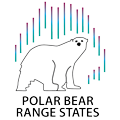Ensure that international trade of polar bears is carried out according to conservation principles
- Objective Lead:
- Action associated with Objective 6 in the 2020-2023 Implementation Plan (see sidebar for further information)
- Polar Bear threats linked to the Objective and how the Objective’s Actions will address them:
- Expected impact (outcome) of the Objective:
- How the progress toward the Objective will be evaluated:
- Performance Metrics:
- Baseline of Performance Metrics:
- Liaison with other CAP-Objectives:
- Liaison with external bodies
- Expected dissemination of Deliverables and Outcome to stakeholders
Objective Lead:
Action associated with Objective 6 in the 2020-2023 Implementation Plan (see sidebar for further information)
T-1: Review and Analysis of Canadian Trade in Polar Bears from 2012 - 2021
Polar Bear threats linked to the Objective and how the Objective’s Actions will address them:
Threat 1: Unsustainable harvest
Threat 2: Illegal take/poaching
Action T-1 will lead to the production of an updated assessment of harvest and trade patterns as a basis for future policy and decision-making on matters related to unsustainable harvest and illegal take/poaching.
Levels of the Threats:
Threat 1: Unsustainable harvest = medium – low
Threat 2: Illegal take/poaching = low
Expected impact (outcome) of the Objective:
Short – medium term: The review and analysis of Canadian polar bear harvest and trade from 2012 to 2021 was made available to the public on the Range States website in 2022.
Long-term: International trade will (continue to) be carried out in compliance with CITES.
Long-term: There will be an increase in the use of agreed tagging procedures for harvested bears and bears taken in defense of life and property.
How the progress toward the Objective will be evaluated:
1. International trade will (continue to) be carried out in compliance with CITES.
2. Ongoing monitoring of CITES violations.
3. Ongoing monitoring of incidents of poaching and enforcement response.
4. Review of the proportion of Trade Working Group reccomendations that have been implemented by all Range States.
Performance Metrics:
1. Number of subpopulations that have received non-detriment findings by CITES.
2. Numbers of seizures of polar bear parts in illegal trade; numbers of illegally harvested bears; and numbers of enforcement actions.
Baseline of Performance Metrics:
-
“The 2015 and 2022 trade reports written by Ernie Cooper jointly provide good baseline data from which to measure the success of the Objective as it applies to legal harvest and trade.
-
The 2022 trade report written by Ernie Cooper summarizes illegal polar bear kills by sex and jurisdiction and provides a good baseline for review of illegal harvest.
-
The report on international trade given at the Range States Meeting of the Parties in February 2018 will also serve as a good baseline.
Liaison with other CAP-Objectives:
There is some degree of connection between sustainable international trade of polar bear (Objective 6) and sustainable harvest of polar bear (Objective 4). The key point from the trade perspective is whether allowing export is harmful to the survival of the species in the wild. Objective 4 will consider what constitutes a sustainable harvest. Objective 6 will consider harvest levels, whether harvest aligns with accepted assessments of what is sustainable, and if commercial export is a relevant driver of harvest demand.
Liaison with external bodies
(i.e. organizations, communities, stakeholders, expert groups, etc.):
External body – Independent Contractor: The Government of Canada hiredhd Ernie Cooper on a contract to conduct a review and analysis of Canadian polar bear harvest and trade from 2012 to 2021. The resulting information should be interpreted in relation to similar information, which was included in a report covering the 2005 to 2014 period. The services of an expert in field of wildlife trade issues was required to conduct the assessment. This liaison between the Range States and an independent contractor did not cause any increased risk to the successful completion of the Objective, but rather, was integral to the successful completion of the Objective.
External body – Indigenous partners: Indigenous peoples in Canada have a legal right to harvest polar bear under established Crown-Indigenous Treaties and Land Claims Agreements. Non-Indigenous people are prohibited from harvesting the species in normal circumstances but may participate in a ‘guided hunt’ of polar bear if accompanied by an Indigenous guide in accordance with territorial regulations in Nunavut and the Northwest Territories. Exports of any polar bear products obtained during hunts are only permitted if it is the opinion of the exporting country’s CITES Scientific Authority that the trade will not be detrimental to the survival of the species in the wild. The results of the report produced by Ernie Cooper (i.e. Action T-1) may help Canada’s CITES Scientific Authority determine whether the trade of Canadian polar bear products is detrimental to the survival of the species in the wild.
Expected dissemination of Deliverables and Outcome to stakeholders
(public, policy makers, legislators etc.):
The report written by Ernie Cooper (private contractor) compiles, summarizes and assesses information on polar bear harvest and trade from 2012 to 2021. This report helped determine that current polar bear harvest levels are sustainable in the long-term, and commercial trade of polar bear is non-detrimental to the survival of the species in the wild.
Dissemination to stakeholders: The final version of the report was posted on the Polar Bear Range States website and thus, is accessible to Range State partners, Indigenous partners, stakeholders, and members of the public.
Overall impact/outcome: The report compiles, summarizes and assesses information on polar bear harvest and trade from 2012 to 2021. The information was interpreted in relation to similar information, which was included in a report covering the 2005 to 2014 period. Significant changes or trends were identified and an assessment was conducted of the impact of trade on the long-term viability of polar bear in Canada.
[1] The level of challenge may be estimated by multiplying the level of likelihood (scale 1-5) by the negative impact it may have (scale 1-5). Minor: 1-10, Moderate: 11-15; Severe: 16-25.
